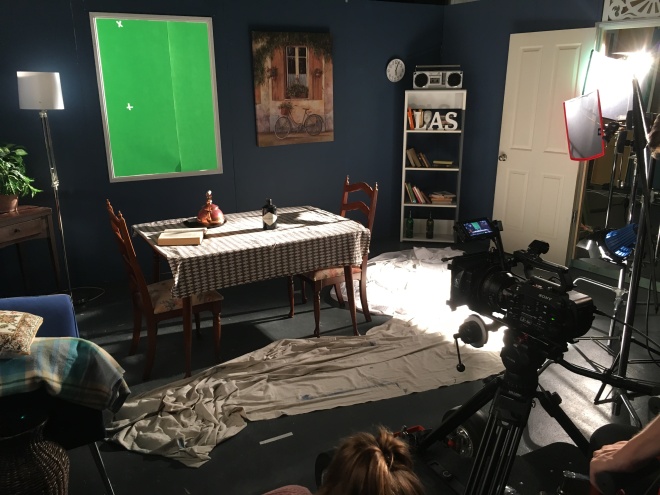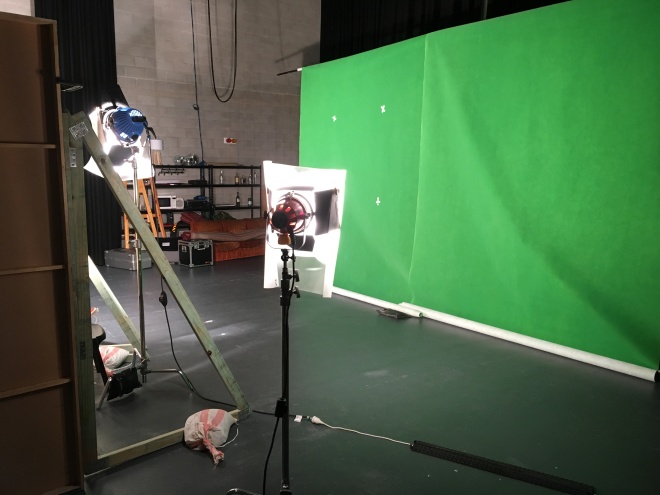I was a part of creating something new! A music video, to be more precise, for “Meant To Be”, a song from upcoming Australian musician Demi Cruickshanks, whose SoundCloud can be found here. It is not only new in that it’s freshly made but also new in that I’ve never been part of a music video before and the experience was different to how I expected, meaning through the process, I learned a great deal. I will update this post soon with a link to the uploaded video so you all can watch it, so keep an eye out.

While this was a client project, the client we were working for was not particularly demanding of us, and so I feel that this is a poor representation of what a client project in the real world would work as. The main difference between the producing this video rather than previous projects that I have worked on is the genre of the content we created, which had a much larger impact on the process than we believed it would, even as we were undertaking the process. I’ve certainly learned quite a lot about the creation of music videos but gained a lot less knowledge about the process of working with and for a client. The main difference was that we checked in with the artist about where the video was at in the creative process at different stages around that process, which is something that does not need to be done when there is no client, and so no one outside the project who has a measure of creative control over it. I can see that this could potentially be a large issue that would have to be tackled, especially for larger scale productions with much more time, effort and most importantly money poured into them, where clients and/or producers and/or advertising agency representatives have final say over the creative direction of a project that they were not remotely involved with before that point. I can see myself having to learn to deal with those types of interactions because at the moment I’m not sure I would be able to handle too well.
During the process of creating this music video, there were some problems, both minor and major, which arose and had to be dealt with in order to end up with a finished product at all. Some of the minor problems we experienced were things like actual athletes practising on the track we were filming on at the same time, without us being allowed to interrupt their routines, or having very limited space and powerpoints to work with in the bedroom we were filming in, or very nearly or even very actually running behind schedule. However, these types of problems both crop up on every film set and are quite straightforward to deal with, so are hardly worth mentioning really, more facts of life than serious problems. The major problems were where things got difficult. The biggest example of this type of near show-stopping problem that we ran headfirst into was that at no point during production did we record in-camera audio. This is a massive and classic rookie mistake, and ultimately the blame for this one lies with me. I was in charge of camera and just had it in my head that, because we were making a music video and no audio from the set would be used, that we wouldn’t need it at all, and so I didn’t bother to record it. I didn’t go out of my way to not record audio, I just didn’t bother to check one way or the other. Lesson learned: ALWAYS RECORD IN-CAMERA AUDIO. Even if you don’t think you need it. The actual problem that we found was because we didn’t have in camera audio, syncing the video of the artist singing her song to the audio of the actual song became very very difficult, and had to be done entirely by hand, with only visual confirmation. The brute force method: keep working at it until it works. But this was far from the only headache we had. One of our locations fell through on the morning that we were meant to shoot, prompting some emergency meetings and restructuring of what we were going to shoot, how we were going to show it, and where we would have it take place. We pulled together as a team brilliantly and worked out a stopgap solution, but ultimately the scene ended up on the cutting room floor. A final large problem we had during the process of creating this video was actually a lack of time dedicated to post-production, due to us as a group having weak time management and shooting quite late into the process. Almost immediately after we shot, the deadline was looming, and so creating a functional video that we were happy with was a tight squeeze into the time that we had left.

We were not completely without our successes, however. Overall, the story that we were trying to tell came across worked, and translated to the viewer, which is something I’m quite proud of, given the storytelling restrictions of not dialogue and pushing 3 stories all through at once, parallel to one another. Additionally, our auditions ran very smoothly, and the actors that were cast in all the roles were both very easy to get along with (with a singular exception) and very dedicated to the project. This particularly applied to our leads, with whom we all got along with very well and who were happy to put in all the time and effort necessary, without hesitation or complaint. Also, the amount of footage that we captured throughout production was almost perfect for the length of the video, meaning that we were able to accurately predict how long each story should go for, and how much coverage we needed for this story to not just come across to the audience, but also keep things interesting and dynamic.
I think that on the whole, we delivered a project that is serviceable, if not overwhelmingly fantastic. There are some great moments in the video, but the video as a whole is kind of cliched and falls into a lot of tropes. This was not outside the realm of the client’s expectation, but other people that we showed the video to have pulled this up as a problem, explaining it seemed like we were not particularly creative in coming up with the project, which obviously doesn’t reflect super well on us. Despite this, I think that we did meet the brief, we just didn’t exceed any expectations and create something transcendental. I’m not trying to say that client expectations were low, but they were certainly lower than the expectations than those of others who were around the project, and it’s these higher levels that we were not able to meet.

Overall, given the problems that we encountered or created for ourselves during the production of this project, I think that it turned out alright. The process and final product could have been improved with the recording of audio, more airtight securing of locations and better time management, but none of these things were deal breakers. The core reason that the music video is not as good as we wanted it to be, and nowhere near the level that it could have reached, with the major thing holding us back on this project being ourselves, and our approach to this project. You see, we approached this music video as we would a short film. Trying to impart a narrative, following continuity, attempting to have narrative pacing, focussing on trying to put subtext into the visuals, rather than allow the song to give the visuals depth. We thought more in terms of how having to keep to the beat and themes of the song, and not being able to incorporate dialogue or sound effect limited us in telling a cohesive story, rather than embracing the experimental nature of music videos and freeing ourselves from sticking to a rigid structure. I view is all as a learning experience though, and I’m glad that I did it. I learned a great deal which I am keen to take into future projects, and I really want to try something like this again soon.








 Next up is a short, slightly non-narrative single shot that I was gaffer on, which in this context means a partner and I created the look of all the lighting seen. In addition I was grip and assistant camera, so I also set up the jib the camera is on as well as setting up the camera itself, but that’s beside the point really. The point is: look at the pretty lighting. Also, this doesn’t have credits yet because I am not much of an editor.
Next up is a short, slightly non-narrative single shot that I was gaffer on, which in this context means a partner and I created the look of all the lighting seen. In addition I was grip and assistant camera, so I also set up the jib the camera is on as well as setting up the camera itself, but that’s beside the point really. The point is: look at the pretty lighting. Also, this doesn’t have credits yet because I am not much of an editor.






 Finally, the other project that I worked on was something that I genuinely cannot show you anything of because I don’t have any of the footage. The placeholder name it was given that just never got changed to a real name was Project X, and it was a collaboration between games students, design students and film students. The games students designed a board game, the design students created all the art and elements involved, and we the film students filmed press statements that the mayor of the small country town the game was set in delivered. It was one of the larger sets I’ve worked on, and certainly the highest calibre of set I’ve worked on. While my role as telecaster operator didn’t seem overly glamorous when it was first assigned to me, it turned out to be quite central, as I was constantly working with the actor and interfacing with many central roles on set. A solid 10 hours on set that I greatly enjoyed and would easily do again.
Finally, the other project that I worked on was something that I genuinely cannot show you anything of because I don’t have any of the footage. The placeholder name it was given that just never got changed to a real name was Project X, and it was a collaboration between games students, design students and film students. The games students designed a board game, the design students created all the art and elements involved, and we the film students filmed press statements that the mayor of the small country town the game was set in delivered. It was one of the larger sets I’ve worked on, and certainly the highest calibre of set I’ve worked on. While my role as telecaster operator didn’t seem overly glamorous when it was first assigned to me, it turned out to be quite central, as I was constantly working with the actor and interfacing with many central roles on set. A solid 10 hours on set that I greatly enjoyed and would easily do again.